-
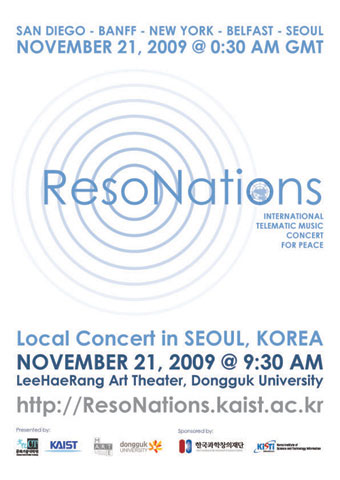 Int'l Telematic Music Concert for Peace to Take Place on Nov. 20
Renowned musicians in five international locations perform new contemporary music works for peace through a real-time performance on the internet. Local audiences in Seoul, Banff, New York, San Diego and Belfast will also have a chance to hear a program.
In Seoul, the "International Telematic Music Concert for Peace" will be held at the LeeHaeRang Art Theater, Dongguk University, in Seoul on Nov. 20 at 9:30 a.m., under the presentation of KAIST"s Graduate School of Culture Technology and MARTE Lab, Dongguk University. Telematic music is real-time performance via the internet by musicians in different geographic locations.
The program of the concert includes "Hope"s Dream" by Mark Dresser and Sarah Weaver; "Disparate Bodies" by Pedro Rebelo, "Rock, Paper, Scissors" by Chris Chafe. The Korean act to be performed is "Green-colored Harmony" by Jun Kim.
In addition to the two Korean universities, the World Association of Former United Nations Internes and Fellows (WAFUNIF), University of California San Diego, the Banff Center of Canada and Queen"s University in Belfast are participating in the project.
The performance will take place on high-bandwidth internet with JackTrip audio software developed by Chris Chafe and Access Grid video software developed at Argonne National Laboratory.
"Connecting the five different cities together through super-speed Internet network and transmitting sound and images in real time is challenging technically. But, we also expect that more exciting results will be created in the course of transforming the sound into visual images," said Woon-Seung Yeo, a professor of the Graduate School of Culture Technology, who was responsible for visuals in the project.
2009.11.19 View 16153
Int'l Telematic Music Concert for Peace to Take Place on Nov. 20
Renowned musicians in five international locations perform new contemporary music works for peace through a real-time performance on the internet. Local audiences in Seoul, Banff, New York, San Diego and Belfast will also have a chance to hear a program.
In Seoul, the "International Telematic Music Concert for Peace" will be held at the LeeHaeRang Art Theater, Dongguk University, in Seoul on Nov. 20 at 9:30 a.m., under the presentation of KAIST"s Graduate School of Culture Technology and MARTE Lab, Dongguk University. Telematic music is real-time performance via the internet by musicians in different geographic locations.
The program of the concert includes "Hope"s Dream" by Mark Dresser and Sarah Weaver; "Disparate Bodies" by Pedro Rebelo, "Rock, Paper, Scissors" by Chris Chafe. The Korean act to be performed is "Green-colored Harmony" by Jun Kim.
In addition to the two Korean universities, the World Association of Former United Nations Internes and Fellows (WAFUNIF), University of California San Diego, the Banff Center of Canada and Queen"s University in Belfast are participating in the project.
The performance will take place on high-bandwidth internet with JackTrip audio software developed by Chris Chafe and Access Grid video software developed at Argonne National Laboratory.
"Connecting the five different cities together through super-speed Internet network and transmitting sound and images in real time is challenging technically. But, we also expect that more exciting results will be created in the course of transforming the sound into visual images," said Woon-Seung Yeo, a professor of the Graduate School of Culture Technology, who was responsible for visuals in the project.
2009.11.19 View 16153 -
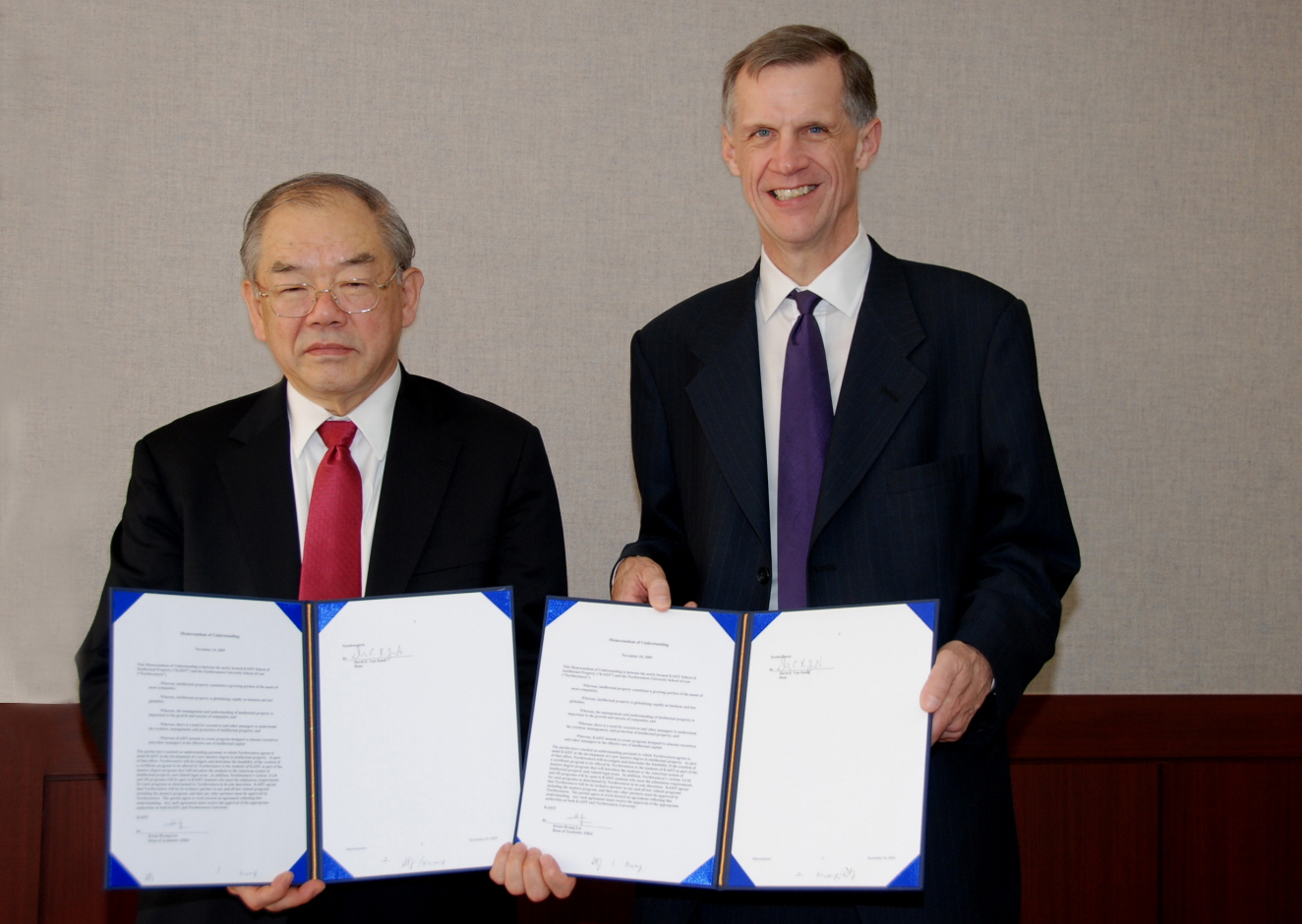 KAIST to Join Forces with Northwestern School of Law in MIP Program
KAIST has agreed to collaborate in its Master of Intellectual Property (MIP) program with Northwestern University School of Law, the university authorities said on Wednesday (Nov. 11).
KAIST President Nam-Pyo Suh and Northwestern Univ. School of Law Dean David Van Zandt signed a memorandum of understanding for the establishment of the certificate and degree programs of the Anglo-American law in February 2010, at the president"s office Wednesday.
The latest agreement represents an expansion of the existing KAIST-Northwestern Executive LLM program that the two schools have successfully operated for the past eight years. It is aimed at boosting KAIST"s global intellectual property capabilities at a time when the strategic management of intellectual properties and capabilities to deal with international intellectual property disputes are gaining growing importance.
The newly-established two-year, six-semester program is designed to offer a certificate program in the Anglo-American and intellectual property laws to make students better armed with legal knowledge in a competitive global environment.
Northwestern University School of Law is regarded as one of the top law schools in the United States. American law schools are better positioned than any other institutions to prepare students to move from domestic to international practice in today"s complex global economy.
LLM is Latin for Legum Magister, signifying Master of Laws
. course and neto ba ... signing an agreement to run a joint masters degree program at the KAIST campus in Seou
2009.11.19 View 14926
KAIST to Join Forces with Northwestern School of Law in MIP Program
KAIST has agreed to collaborate in its Master of Intellectual Property (MIP) program with Northwestern University School of Law, the university authorities said on Wednesday (Nov. 11).
KAIST President Nam-Pyo Suh and Northwestern Univ. School of Law Dean David Van Zandt signed a memorandum of understanding for the establishment of the certificate and degree programs of the Anglo-American law in February 2010, at the president"s office Wednesday.
The latest agreement represents an expansion of the existing KAIST-Northwestern Executive LLM program that the two schools have successfully operated for the past eight years. It is aimed at boosting KAIST"s global intellectual property capabilities at a time when the strategic management of intellectual properties and capabilities to deal with international intellectual property disputes are gaining growing importance.
The newly-established two-year, six-semester program is designed to offer a certificate program in the Anglo-American and intellectual property laws to make students better armed with legal knowledge in a competitive global environment.
Northwestern University School of Law is regarded as one of the top law schools in the United States. American law schools are better positioned than any other institutions to prepare students to move from domestic to international practice in today"s complex global economy.
LLM is Latin for Legum Magister, signifying Master of Laws
. course and neto ba ... signing an agreement to run a joint masters degree program at the KAIST campus in Seou
2009.11.19 View 14926 -
 KAIST, CJ Sign MOU for Joint Research in Fundamental Technologies
KAIST and CJ Corporation, Korea"s leading foodstuff maker, have reached an agreement for an enhanced industry-academy cooperation in the biotechnology area, the university authorities said on Tuesday (Nov. 10).
KAIST President Nam-Pyo Suh signed a memorandum of understanding with Kim Jin-soo, CEO of CJ, at the KAIST campus on Tuesday (Nov. 10).
Under the agreement, KAIST and CJ will cooperate in nurturing elite research manpower and conducting joint researches in fundamental technologies. Specifically, CJ researchers will suggest research subjects linked with doctorate programs to KAIST, and once these subjects are accepted by KAIST, CJ researchers will conduct research under the guidance of KAIST professors to get doctorate degrees. All the costs including research expenses incurred during the program will be provided by CJ.
The agreement also calls for CJ to provide funding for the research subjects it selected among the ones suggested by KAIST"s biotechnology professors.
CJ CEO Jin-Soo Kim said: "Through the joint researches with KAIST which has the highest research capabilities, CJ can strengthen basic research capabilities and secure elite research manpower. We hope that the KAIST-CJ partnership will become a successful model for cooperation between industry and academia."
2009.11.11 View 14415
KAIST, CJ Sign MOU for Joint Research in Fundamental Technologies
KAIST and CJ Corporation, Korea"s leading foodstuff maker, have reached an agreement for an enhanced industry-academy cooperation in the biotechnology area, the university authorities said on Tuesday (Nov. 10).
KAIST President Nam-Pyo Suh signed a memorandum of understanding with Kim Jin-soo, CEO of CJ, at the KAIST campus on Tuesday (Nov. 10).
Under the agreement, KAIST and CJ will cooperate in nurturing elite research manpower and conducting joint researches in fundamental technologies. Specifically, CJ researchers will suggest research subjects linked with doctorate programs to KAIST, and once these subjects are accepted by KAIST, CJ researchers will conduct research under the guidance of KAIST professors to get doctorate degrees. All the costs including research expenses incurred during the program will be provided by CJ.
The agreement also calls for CJ to provide funding for the research subjects it selected among the ones suggested by KAIST"s biotechnology professors.
CJ CEO Jin-Soo Kim said: "Through the joint researches with KAIST which has the highest research capabilities, CJ can strengthen basic research capabilities and secure elite research manpower. We hope that the KAIST-CJ partnership will become a successful model for cooperation between industry and academia."
2009.11.11 View 14415 -
 Prof. Woo's Team Discovers Eco-Friendly Solid-Oxide Fuel Cell System
A KAIST research team led by Prof. Seong-Ihl Woo of the Department of Chemical & Biomolecular Engineering has found a method to use glycerol, a byproduct from the production of biodiesel, as fuel for solid oxide fuel cells (SOFC), university authorities said on Tuesday (Oct. 27).
The research finding shows that glycerol can be an environmentally sustainable fuel when it is used for operating SOFCs with internal reforming, instead of hydrogen and methane. The finding was published in the Oct. 14, 2009 online edition of ChemSusChem, a sister journal of Angewandte Chemie, the world"s leading chemistry journal.
Biodiesel is an attractive alternative energy source because of its low sulfur content and demand is growing worldwide as oil price soars. Bio-derived glycerol will not contribute to the greenhouse effect and has the potential to contribute to reducing global warming.
Currently, glycereol is used as a raw material in the cosmetic, pharmacy, food, and tobacco industries. However, its supply exceeds its demand as the volume of biodiesel production increases. The production of 1 ton of biodiesel produces 0.1 ton of glycerol. Many researchers have investigated various routes for the consumption of surplus glycerol.
The research is expected to contribute to sustainable growth by reducing the emissions of carbon dioxide and reusing generated carbon dioxide for the production of biomass. The new method enables manufacturers to use glycerol as a fuel for operating SOFC.
2009.10.28 View 15327
Prof. Woo's Team Discovers Eco-Friendly Solid-Oxide Fuel Cell System
A KAIST research team led by Prof. Seong-Ihl Woo of the Department of Chemical & Biomolecular Engineering has found a method to use glycerol, a byproduct from the production of biodiesel, as fuel for solid oxide fuel cells (SOFC), university authorities said on Tuesday (Oct. 27).
The research finding shows that glycerol can be an environmentally sustainable fuel when it is used for operating SOFCs with internal reforming, instead of hydrogen and methane. The finding was published in the Oct. 14, 2009 online edition of ChemSusChem, a sister journal of Angewandte Chemie, the world"s leading chemistry journal.
Biodiesel is an attractive alternative energy source because of its low sulfur content and demand is growing worldwide as oil price soars. Bio-derived glycerol will not contribute to the greenhouse effect and has the potential to contribute to reducing global warming.
Currently, glycereol is used as a raw material in the cosmetic, pharmacy, food, and tobacco industries. However, its supply exceeds its demand as the volume of biodiesel production increases. The production of 1 ton of biodiesel produces 0.1 ton of glycerol. Many researchers have investigated various routes for the consumption of surplus glycerol.
The research is expected to contribute to sustainable growth by reducing the emissions of carbon dioxide and reusing generated carbon dioxide for the production of biomass. The new method enables manufacturers to use glycerol as a fuel for operating SOFC.
2009.10.28 View 15327 -
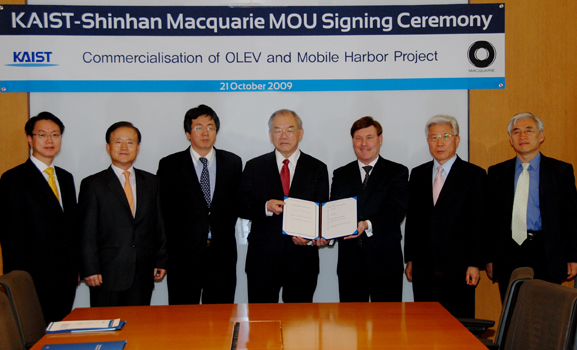 KAIST Signs MOU with Macquarie for Cooperation in Green Growth Projects
KAIST and Shinhan Macquarie Financial Advisory Co. have reached an agreement for cooperation in the development and commercialization of the KAIST-led two national green growth projects, On-line Electric Vehicle (OLEV) and Mobile Harbor (MH) programs, university authorities said.
KAIST President Nam-Pyo Suh signed a memorandum of understanding with John Walker, Chairman of Macquarie Group of Companies in Korea, and Woo-Gon Hwang, Representative Director of Shinhan Macquarie Financial Advisory Co. on Wednesday, Oct. 21.
Under the agreement, KAIST and Macquarie will cooperate in developing an optimal business structure for a rapid commercialization of OLEV and MH. Specifically, Shinhan Macquarie Financial Advisory will provide financial advice, including basis financial analysis, potential investor inducement and feasibility analysis of the projects.
Shinhan Macquarie Financial Advisory Co. is a joint venture between Shinhan Financial Group of Korea and the Australia-based Macquarie Bank Group which provides global investment banking and diversified financial services.
KAIST"s OLEV is a project to develop a new growth engine for Korea and lead the future of global automotive industry. It is an entirely new concept: the electric vehicle picks up power from underground power supplier lines, while either running or standing, through the non-contact magnetic charging method.
The MH program is designed to develop a system that can load/unload containers from a containership in the open sea and deliver them to their destinations at the harbor.
The Korean government has included these KAIST projects, which both are great technical and engineering challenges, in the nation"s sustainable growth programs, providing substantial research grants. KAIST offers its advanced research capabilities for the nation"s efforts to achieve efficient, environment-friendly utilization of resources as new growth engines that spur the development of related industries and explore global markets.
2009.10.22 View 16318
KAIST Signs MOU with Macquarie for Cooperation in Green Growth Projects
KAIST and Shinhan Macquarie Financial Advisory Co. have reached an agreement for cooperation in the development and commercialization of the KAIST-led two national green growth projects, On-line Electric Vehicle (OLEV) and Mobile Harbor (MH) programs, university authorities said.
KAIST President Nam-Pyo Suh signed a memorandum of understanding with John Walker, Chairman of Macquarie Group of Companies in Korea, and Woo-Gon Hwang, Representative Director of Shinhan Macquarie Financial Advisory Co. on Wednesday, Oct. 21.
Under the agreement, KAIST and Macquarie will cooperate in developing an optimal business structure for a rapid commercialization of OLEV and MH. Specifically, Shinhan Macquarie Financial Advisory will provide financial advice, including basis financial analysis, potential investor inducement and feasibility analysis of the projects.
Shinhan Macquarie Financial Advisory Co. is a joint venture between Shinhan Financial Group of Korea and the Australia-based Macquarie Bank Group which provides global investment banking and diversified financial services.
KAIST"s OLEV is a project to develop a new growth engine for Korea and lead the future of global automotive industry. It is an entirely new concept: the electric vehicle picks up power from underground power supplier lines, while either running or standing, through the non-contact magnetic charging method.
The MH program is designed to develop a system that can load/unload containers from a containership in the open sea and deliver them to their destinations at the harbor.
The Korean government has included these KAIST projects, which both are great technical and engineering challenges, in the nation"s sustainable growth programs, providing substantial research grants. KAIST offers its advanced research capabilities for the nation"s efforts to achieve efficient, environment-friendly utilization of resources as new growth engines that spur the development of related industries and explore global markets.
2009.10.22 View 16318 -
 KAIST Wins Official Membership of ERCIS
The Center for Software Policy Study of KAIST has recently become the 20th official member of the European Research Center for Information Systems (ERCIS) by signing an agreement with the organization, university authorities said on Thursday (Oct. 22).
The ERCIS is a network of scientists who conduct cooperative research in the field of integrated information systems development and organizational design. The Center undertakes interdisciplinary research with the participation of computer scientists, business management experts and law scholars.
KAIST will seek to activate exchange of professors, research fellows and graduate students with ERCIS members, as well as implementing credit exchange and dual degree programs.
ERCIS, was first organized by the German state of North Rhine-Westfahlia, is currently managed by the University of Muenster, a global leader in the field of information systems and business administration. Joining the ERCIS are one university each from New Zealand, the Netherlands, Germany, Russia, Liechtenstein, the United States, Switzerland, Spain, Slovenia, Ireland, Britain, Austria, Italy, the Czech Republic, Poland, France, Finland and Australia.
KAIST"s Center for Software Policy Study is currently preparing for the establishment of a support system for developers of the mobile application software as part of the EUREKA project. Korea is playing a leading role in this project on the strength of its competitiveness in the mobile phone industry.
EUREKA is a pan-European intergovernmental network for market-oriented, industrial R&D aimed at enhancing European competitiveness through its support to businesses, research centers and universities who carry out pan-European projects to develop innovative products, processes and services.
2009.10.22 View 15413
KAIST Wins Official Membership of ERCIS
The Center for Software Policy Study of KAIST has recently become the 20th official member of the European Research Center for Information Systems (ERCIS) by signing an agreement with the organization, university authorities said on Thursday (Oct. 22).
The ERCIS is a network of scientists who conduct cooperative research in the field of integrated information systems development and organizational design. The Center undertakes interdisciplinary research with the participation of computer scientists, business management experts and law scholars.
KAIST will seek to activate exchange of professors, research fellows and graduate students with ERCIS members, as well as implementing credit exchange and dual degree programs.
ERCIS, was first organized by the German state of North Rhine-Westfahlia, is currently managed by the University of Muenster, a global leader in the field of information systems and business administration. Joining the ERCIS are one university each from New Zealand, the Netherlands, Germany, Russia, Liechtenstein, the United States, Switzerland, Spain, Slovenia, Ireland, Britain, Austria, Italy, the Czech Republic, Poland, France, Finland and Australia.
KAIST"s Center for Software Policy Study is currently preparing for the establishment of a support system for developers of the mobile application software as part of the EUREKA project. Korea is playing a leading role in this project on the strength of its competitiveness in the mobile phone industry.
EUREKA is a pan-European intergovernmental network for market-oriented, industrial R&D aimed at enhancing European competitiveness through its support to businesses, research centers and universities who carry out pan-European projects to develop innovative products, processes and services.
2009.10.22 View 15413 -
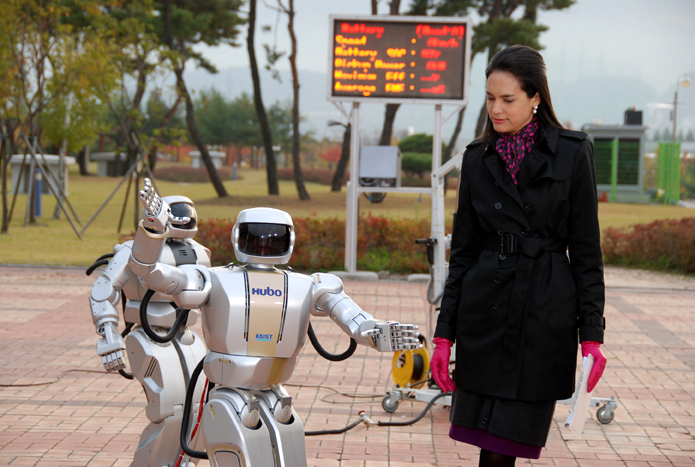 National Green Growth Project, Online Electric Vehicle, Showcased on CNN
KAIST"s green growth technologies were broadcast live on U.S. cable news network CNN from 8 a.m. to 9:30 a.m. Oct. 21.
The program was part of CNN"s week-long series, titled "Eye on South Korea," focusing on how Korea is working to become a brand leader on an international scale and how the nation is recovering from the global economic recession.
During the broadcast, award-winning CNN anchor and correspondent Kristie Lu Stout interviewed KAIST President Nam-Pyo Suh to hear about KAIST-developed two green-growth projects, On-Line Electric Car and Mobile Harbor. KAIST"s humanoid robot Hubo was also showcased.
Live broadcasts of "Eye on South Korea" aired from Oct. 21 through 23.
2009.10.21 View 15791
National Green Growth Project, Online Electric Vehicle, Showcased on CNN
KAIST"s green growth technologies were broadcast live on U.S. cable news network CNN from 8 a.m. to 9:30 a.m. Oct. 21.
The program was part of CNN"s week-long series, titled "Eye on South Korea," focusing on how Korea is working to become a brand leader on an international scale and how the nation is recovering from the global economic recession.
During the broadcast, award-winning CNN anchor and correspondent Kristie Lu Stout interviewed KAIST President Nam-Pyo Suh to hear about KAIST-developed two green-growth projects, On-Line Electric Car and Mobile Harbor. KAIST"s humanoid robot Hubo was also showcased.
Live broadcasts of "Eye on South Korea" aired from Oct. 21 through 23.
2009.10.21 View 15791 -
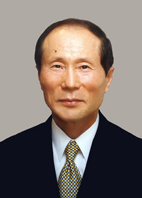 Board Chairman Chung Makes First Visit to Building Named After Him
Moon-Soul Chung, chairman of the KAIST board of trustees, visited the building built with his donation on Monday (Oct. 19) for the first time since he made the deed of gift eight years ago, university authorities said on Monday (Oct. 19).
In 2000, Chung, founder and former CEO of Mirae Corp, manufacturer of semiconductor testing equipment, announced retirement and handed over the presidency of his company to one of his managing directors. One year later in 2001, he donated 30 billion won, then equivalent to $30 million, to KAIST. It was by then the largest amount given by a single donor.
The major part of his donation went to constructing a building for the newly-established Department of Bio and Brain Engineering, and it was named after him. However, Chung did not attend the ground-breaking and dedication ceremonies, saying that he would not enter the building until KAIST achieved a breakthrough technology which can inject a hope to Koreans.
On his first visit to the building, he was briefed on the major research outcomes of the department over the past seven years, which were highlighted by the recent invention of an apparatus for measuring perfusion rate of legs. A KAIST team headed by Prof. Chul-Hee Choi invented a light leakage prevention unit including a light emitting device for radiating light having a certain wavelength onto a living body injected with Indocyanine Green (ICG).
According to Prof. Choi, the invention relates to an apparatus for measuring the perfusion rate of legs. The invention also includes a light leakage prevention housing formed to prevent transmission of external light.
Chung expressing satisfaction with the achievements and encouraged professors, researchers and students working at the Moon-Soul Chung Building.
2009.10.20 View 16273
Board Chairman Chung Makes First Visit to Building Named After Him
Moon-Soul Chung, chairman of the KAIST board of trustees, visited the building built with his donation on Monday (Oct. 19) for the first time since he made the deed of gift eight years ago, university authorities said on Monday (Oct. 19).
In 2000, Chung, founder and former CEO of Mirae Corp, manufacturer of semiconductor testing equipment, announced retirement and handed over the presidency of his company to one of his managing directors. One year later in 2001, he donated 30 billion won, then equivalent to $30 million, to KAIST. It was by then the largest amount given by a single donor.
The major part of his donation went to constructing a building for the newly-established Department of Bio and Brain Engineering, and it was named after him. However, Chung did not attend the ground-breaking and dedication ceremonies, saying that he would not enter the building until KAIST achieved a breakthrough technology which can inject a hope to Koreans.
On his first visit to the building, he was briefed on the major research outcomes of the department over the past seven years, which were highlighted by the recent invention of an apparatus for measuring perfusion rate of legs. A KAIST team headed by Prof. Chul-Hee Choi invented a light leakage prevention unit including a light emitting device for radiating light having a certain wavelength onto a living body injected with Indocyanine Green (ICG).
According to Prof. Choi, the invention relates to an apparatus for measuring the perfusion rate of legs. The invention also includes a light leakage prevention housing formed to prevent transmission of external light.
Chung expressing satisfaction with the achievements and encouraged professors, researchers and students working at the Moon-Soul Chung Building.
2009.10.20 View 16273 -
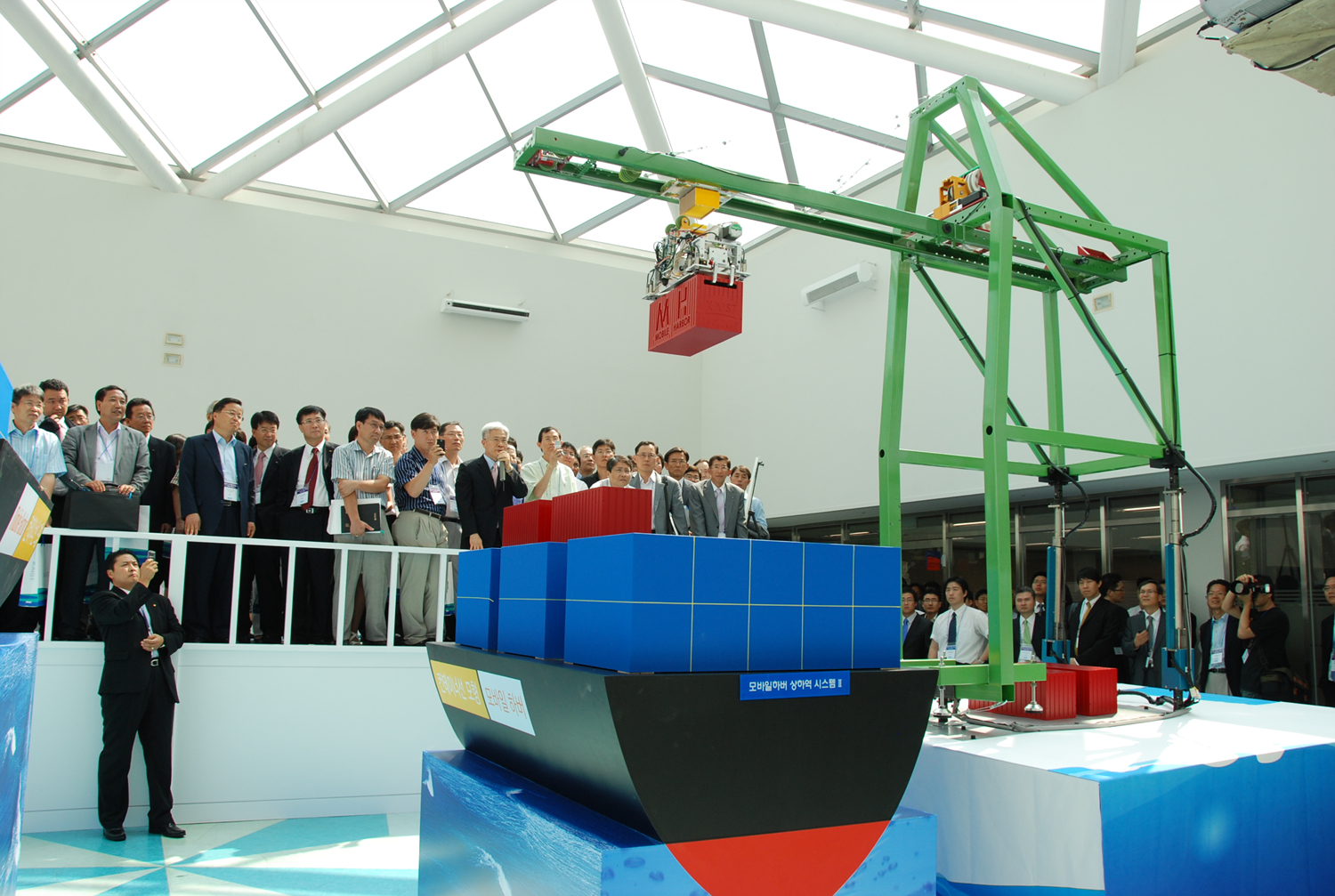 KAIST's Mobile Harbor Program Attracts Two Corporate Investments
KAIST-developed Mobile Harbor Program has attracted investments from Korea"s two big-name industrial corporations, university authorities said on Monday (Oct. 19).
KAIST has recently signed an agreement with Hyundai Wia Corp., a machine parts supplier, to collaborate in the researches of the mobile harbor programs and commercialization. Under the agreement, Hyundai WIA will invest a total of 7.5 billion won in the program for two years starting from January 2010.
KAIST has also received a letter of intent from the Daewoo Shipbuilding & Marine Engineering Co. on investing 20 billion won in the commercialization of the project.
The Mobile Harbor Program is designed to create mobile units that can go out to the ship which are anchored off-shore and unload the cargo and take it to where it is needed. It is aimed at overcoming the shortcomings of the current maritime container transportation systems. Container ships are getting larger and larger, requiring deep waters, large and complex loading and unloading systems, and major investments in facilities.
Prof. Byung-Man Kwak, leader of the program"s R&D team, said: "With the investment from two global industrial companies, the program has gained a crucial momentum. The development of the program is expected to help Korea to become a global leader in marine transportation and maintain its supremacy in shipbuilding."
2009.10.20 View 18481
KAIST's Mobile Harbor Program Attracts Two Corporate Investments
KAIST-developed Mobile Harbor Program has attracted investments from Korea"s two big-name industrial corporations, university authorities said on Monday (Oct. 19).
KAIST has recently signed an agreement with Hyundai Wia Corp., a machine parts supplier, to collaborate in the researches of the mobile harbor programs and commercialization. Under the agreement, Hyundai WIA will invest a total of 7.5 billion won in the program for two years starting from January 2010.
KAIST has also received a letter of intent from the Daewoo Shipbuilding & Marine Engineering Co. on investing 20 billion won in the commercialization of the project.
The Mobile Harbor Program is designed to create mobile units that can go out to the ship which are anchored off-shore and unload the cargo and take it to where it is needed. It is aimed at overcoming the shortcomings of the current maritime container transportation systems. Container ships are getting larger and larger, requiring deep waters, large and complex loading and unloading systems, and major investments in facilities.
Prof. Byung-Man Kwak, leader of the program"s R&D team, said: "With the investment from two global industrial companies, the program has gained a crucial momentum. The development of the program is expected to help Korea to become a global leader in marine transportation and maintain its supremacy in shipbuilding."
2009.10.20 View 18481 -
 KAIST Ranked 21st among World's Engineering Universities
KAIST was placed 21st in the area of engineering and information technology in this year"s world university rankings released on Oct. 8 (Thursday), climbing 13 notches from last year"s 34th. Seoul National University (SNU) ranked 27th, which made KAIST and SNU the only two institutions making it to the top 50 list. POSTECH ascended to 81st from last year"s 143rd.
In the "Times Higher Education--QS World University Rankings," Korean universities showed remarkable advancement this year; all-told five Korean universities made it to the top 200 list, as Yonsei and Korea universities were included in the list for the first time.
In overall rankings, KAIST moved 26 notches upward to grab the 69th position in the list, while SNU was placed 47th (50th last year).
The list, compiled by The Times (of London) newspaper annually, is topped by Harvard University, followed by University of Cambridge and Yale University.
Again this year, the United States had most of the top 100 universities in the world, with 32 included in the list. It was followed by the United Kingdom (18), Australia (8) and Japan (6).
Now in their 6th edition, the Times Higher Education--QS World University Rankings received a record level of responses from both the academic community and employers in 2009. A total of 9,386 academics (or 47 percent over 6,354 in 2008) and 3,281 employers (compared to 2,339 in 2008) responded to the surveys.
Times Higher Education -- QS World University Rankings evaluates institutions worldwide in four main categories: quality of research, globalization, quality of education, and contributions of graduates to society. The evaluation also considers academic peer review, citations per faculty, recruiter review, international faculty, international students and faculty-student ratio.
2009.10.09 View 16253
KAIST Ranked 21st among World's Engineering Universities
KAIST was placed 21st in the area of engineering and information technology in this year"s world university rankings released on Oct. 8 (Thursday), climbing 13 notches from last year"s 34th. Seoul National University (SNU) ranked 27th, which made KAIST and SNU the only two institutions making it to the top 50 list. POSTECH ascended to 81st from last year"s 143rd.
In the "Times Higher Education--QS World University Rankings," Korean universities showed remarkable advancement this year; all-told five Korean universities made it to the top 200 list, as Yonsei and Korea universities were included in the list for the first time.
In overall rankings, KAIST moved 26 notches upward to grab the 69th position in the list, while SNU was placed 47th (50th last year).
The list, compiled by The Times (of London) newspaper annually, is topped by Harvard University, followed by University of Cambridge and Yale University.
Again this year, the United States had most of the top 100 universities in the world, with 32 included in the list. It was followed by the United Kingdom (18), Australia (8) and Japan (6).
Now in their 6th edition, the Times Higher Education--QS World University Rankings received a record level of responses from both the academic community and employers in 2009. A total of 9,386 academics (or 47 percent over 6,354 in 2008) and 3,281 employers (compared to 2,339 in 2008) responded to the surveys.
Times Higher Education -- QS World University Rankings evaluates institutions worldwide in four main categories: quality of research, globalization, quality of education, and contributions of graduates to society. The evaluation also considers academic peer review, citations per faculty, recruiter review, international faculty, international students and faculty-student ratio.
2009.10.09 View 16253 -
 KAIST's Industrial Design Program Rated among World's Best
KAIST"s master"s program in the area of industrial design has been rated among the world"s best in the latest survey of the World"s Best Design Programs published in the Oct. 2, 2009 issue of BusinessWeek, university authorities said Wednesday, Oct. 7.
The magazine has selected 30 top design programs at the postgraduate level from all over the world. Only six programs in Asia -- one each in Korea, Japan, China, Hong Kong, Taiwan and India -- were included in the list, while famous design schools in the United States and Europe dominated the list.
Why was KAIST on the list? The magazine commented: "The master"s program, set up in 1991, focuses on human-centered design, technology convergence, and business innovation. Students take courses in design marketing and design management to understand wider corporate issues and also learn how to use design as a strategic tool."
In presenting the list of top design programs, the magazine said that "students in these programs take classes in art, management and science, for example, and create projects in multi-disciplinary teams with students from other schools, They aim to use design for strategy rather than merely for aesthetics and may find jobs as design managers, researchers or business consultants." The magazine concluded that "these programs have formally established hybrid curricula."
Meanwhile, Woo-sung Park, a KAIST graduate, has been chosen among the "Twenty-one People Who Will Change Business" surveyed by the magazine. After graduating with a B.S. in industrial design from KAIST in 2005, Park worked for a design firm for two years. He then returned to KAIST to develop the analytical skills he now uses at the global consultancy Boston Consulting Group in Seoul.
2009.10.09 View 13002
KAIST's Industrial Design Program Rated among World's Best
KAIST"s master"s program in the area of industrial design has been rated among the world"s best in the latest survey of the World"s Best Design Programs published in the Oct. 2, 2009 issue of BusinessWeek, university authorities said Wednesday, Oct. 7.
The magazine has selected 30 top design programs at the postgraduate level from all over the world. Only six programs in Asia -- one each in Korea, Japan, China, Hong Kong, Taiwan and India -- were included in the list, while famous design schools in the United States and Europe dominated the list.
Why was KAIST on the list? The magazine commented: "The master"s program, set up in 1991, focuses on human-centered design, technology convergence, and business innovation. Students take courses in design marketing and design management to understand wider corporate issues and also learn how to use design as a strategic tool."
In presenting the list of top design programs, the magazine said that "students in these programs take classes in art, management and science, for example, and create projects in multi-disciplinary teams with students from other schools, They aim to use design for strategy rather than merely for aesthetics and may find jobs as design managers, researchers or business consultants." The magazine concluded that "these programs have formally established hybrid curricula."
Meanwhile, Woo-sung Park, a KAIST graduate, has been chosen among the "Twenty-one People Who Will Change Business" surveyed by the magazine. After graduating with a B.S. in industrial design from KAIST in 2005, Park worked for a design firm for two years. He then returned to KAIST to develop the analytical skills he now uses at the global consultancy Boston Consulting Group in Seoul.
2009.10.09 View 13002 -
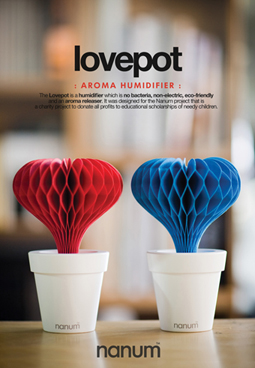 Bae's Design Team Wins Good Design Award
An eco-friendly pot humidifier designed by a KAIST team led by Prof. Sang-Min Bae of the Department of Industrial Design won the G-Mark award at the 2009 Good Design Award, university authorities said on Tuesday (Sept. 29).
The Good Design Award is a Japanese comprehensive design evaluation and commendation system operated by the Japan Industrial Design Promotion Organization (JIDPO). It originated from the Good Design Selection system, known as the "G-Mark System," instituted by the Ministry of International Trade and Industry of Japan in 1957. More than 1,000 companies and designers from 50-odd countries submit about 3,000 entries for consideration for the Good Design Awards each year.
The humidifier controls the indoor humidity by natural vaporization using the tissue ball. The tissue ball is made of honeycomb shaped felt so that it can enhance water absorbing ability with large surface. In the package of the pot, there is a bottle of aroma liquid and people can use it for the fragrances as well as humidification.
The pot, called "Love Pot," was designed for the Nanum (Sharing) Project, a charity activity to establish funds for donations through new products development. International aid organization World Vision, oil company GS Caltex and Prof. Bae"s ID+IM design laboratory have teamed up for the project.
The KAIST team worked for free to design the pot. Profits from the sale of the pots were donated for education programs for low-income households. Among the products made under the Nanum Project was a cross cube MP3 player which won the silver prize at the 2008 International Design Excellence Awards (IDEA). IDEA is one of the world"s top three design awards along with Germany"s International Forum DEsign Awards and the Red Dot Design Awards.
Prof. Bae"s team also won the "Best of the Best" award at Red Dot last November with the "Roly Poly Pot," a planter that tips to the side when the plant is thirsty.
2009.10.01 View 14146
Bae's Design Team Wins Good Design Award
An eco-friendly pot humidifier designed by a KAIST team led by Prof. Sang-Min Bae of the Department of Industrial Design won the G-Mark award at the 2009 Good Design Award, university authorities said on Tuesday (Sept. 29).
The Good Design Award is a Japanese comprehensive design evaluation and commendation system operated by the Japan Industrial Design Promotion Organization (JIDPO). It originated from the Good Design Selection system, known as the "G-Mark System," instituted by the Ministry of International Trade and Industry of Japan in 1957. More than 1,000 companies and designers from 50-odd countries submit about 3,000 entries for consideration for the Good Design Awards each year.
The humidifier controls the indoor humidity by natural vaporization using the tissue ball. The tissue ball is made of honeycomb shaped felt so that it can enhance water absorbing ability with large surface. In the package of the pot, there is a bottle of aroma liquid and people can use it for the fragrances as well as humidification.
The pot, called "Love Pot," was designed for the Nanum (Sharing) Project, a charity activity to establish funds for donations through new products development. International aid organization World Vision, oil company GS Caltex and Prof. Bae"s ID+IM design laboratory have teamed up for the project.
The KAIST team worked for free to design the pot. Profits from the sale of the pots were donated for education programs for low-income households. Among the products made under the Nanum Project was a cross cube MP3 player which won the silver prize at the 2008 International Design Excellence Awards (IDEA). IDEA is one of the world"s top three design awards along with Germany"s International Forum DEsign Awards and the Red Dot Design Awards.
Prof. Bae"s team also won the "Best of the Best" award at Red Dot last November with the "Roly Poly Pot," a planter that tips to the side when the plant is thirsty.
2009.10.01 View 14146